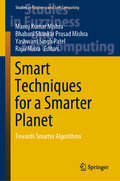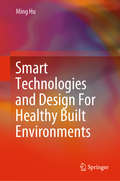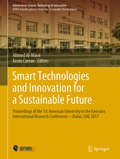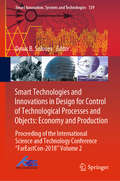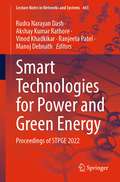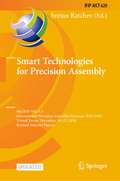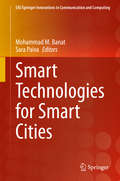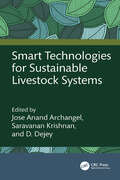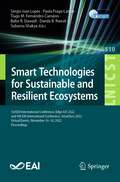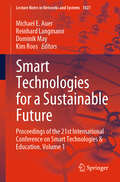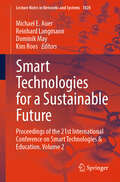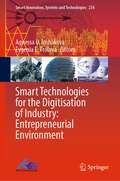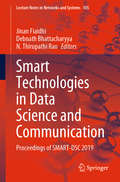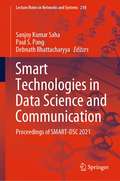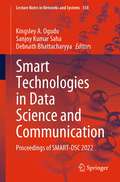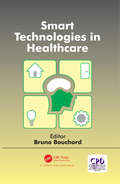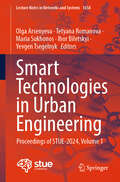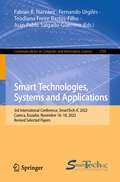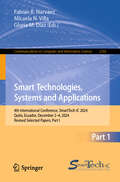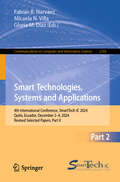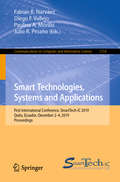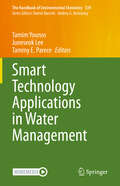- Table View
- List View
Smart Techniques for a Smarter Planet: Towards Smarter Algorithms (Studies in Fuzziness and Soft Computing #374)
by Bhabani Shankar Mishra Manoj Kumar Mishra Yashwant Singh Patel Rajiv MisraThis book is intended to provide a systematic overview of so-called smart techniques, such as nature-inspired algorithms, machine learning and metaheuristics. Despite their ubiquitous presence and widespread application to different scientific problems, such as searching, optimization and /or classification, a systematic study is missing in the current literature. Here, the editors collected a set of chapters on key topics, paying attention to provide an equal balance of theory and practice, and to outline similarities between the different techniques and applications. All in all, the book provides an unified view on the field on intelligent methods, with their current perspective and future challenges.
Smart Technologies and Design For Healthy Built Environments (Springerbriefs In Applied Sciences And Technology Ser.)
by Ming HuSmart Technologies and Design for Healthy Built Environment connects smart technology to a healthy built environmentthat builds upon the sustainable building movement.It provides an overall summary of the state-of-the-art technologies that are applied in the built environment. The book covers a broad spectrum of smart technology categories ranging from dynamic operability, energy efficiency, self-regulating and self-learning systems, and responsive systems. The foreseeable challenges that are associated with smart technologies are discussed and outlined in the book. Firstly, this book provides a snapshot of state-of-the-art smart technologies being applied in the built environment. It covers a broad spectrum of smart technology categories, ranging from dynamic operability, energy efficiency, self-regulating and self-learning systems, to responsive systems. Secondly, this book provides in-depth analysis of the four primary components of health (biological, physical, physiological and psychological); their effects on wellbeing and cognitive performance are introduced as well. Thirdly, it connects smart technologies to those health-influencing factors by reviewing three completed smart building projects. This book can also serve as a basis for education and discussion among professionals and students of diverse backgrounds who are interested in smart technologies, smart building, and healthy building. Smart Technologies and Design for Healthy Built Environment serves as the basis for education and discussions among professionals and students who are interested in smart technologies, smart building and healthy building, as it bridges the gap between smart technologies and a healthy built environment. The book also provides a foundation for anyone who is interested in the impact of smart technology on the health of built environment.
Smart Technologies and Innovation for a Sustainable Future: Proceedings of the 1st American University in the Emirates International Research Conference — Dubai, UAE 2017 (Advances in Science, Technology & Innovation)
by Kevin Curran Ahmed Al-MasriThe book presents high-quality research papers presented at the 1st AUE International research conference, AUEIRC 2017, organized by the American University in the Emirates, held on November 15th-16th, 2017 in Dubai. The book is broadly divided into three sections: Media and Smart Cities, Creative Technologies and Innovation, and Security Risks and Strategic Challenges. The areas covered under these sections are cyber-psychology and digital forensics, cloud RAN architecture, networking functions virtualization, e-Governance and IoT semantic interoperability, ERP security, web-based application and problem-solving skills, smart technologies and advertising, smart technologies for smart cities, smart adaptable navigation systems, turbo codes for security key generation, technology advanced student learning and mobile devices, big data security and privacy, multi-channel buffer enabled technique, physiological signal acquisition in electro-oculography, blockchain and donation-based crowdfunding, smart city and framework development approach, news channel and media education, UAE foreign policy, China-GCC relations, diplomacy in the Internet age, intelligent cyber-security strategies, industry securities and strategic challenges, hybrid alliances and corporate security, security and privacy in smart cities, human computer interaction and e-learning solution, complexity of smart cities governance. The papers included in this book present insightful information on the most recent and relevant research, theories and practices in the field, which aim for a sustainable future.
Smart Technologies and Innovations in Design for Control of Technological Processes and Objects: Proceeding of the International Science and Technology Conference "FarEastСon-2018" Volume 2 (Smart Innovation, Systems and Technologies #139)
by Denis B. SolovevThis book features selected papers presented at The International Science and Technology Conference “FarEastCon”, which took place on October 2–4, 2018 in Vladivostok, Russian Federation.The conference represents an informational platform for accumulating expert opinion on projects and initiatives aimed at the implementation of farsighted scientific research and development; it also allows scientific and practical achievements to be shared with a wide circle of researchers.Sections of the conference are of interest for the broad range of experts involved in developing innovative solutions and organizing events that increase the efficiency of economic and innovative activities.
Smart Technologies for Power and Green Energy: Proceedings of STPGE 2022 (Lecture Notes in Networks and Systems #443)
by Ranjeeta Patel Akshay Kumar Rathore Rudra Narayan Dash Vinod Khadkikar Manoj DebnathThe book is a collection of best selected research papers presented at International Conference on Smart Technology for Power and Green Energy (STPGE 2022), organized by School of Electrical Engineering, KIIT, Deemed to be University, Bhubaneswar, India, during February 12 – 13, 2022. The book discusses recent developments and contemporary research in power electronics and energy.
Smart Technologies for Precision Assembly: 9th IFIP WG 5.5 International Precision Assembly Seminar, IPAS 2020, Virtual Event, December 14–15, 2020, Revised Selected Papers (IFIP Advances in Information and Communication Technology #620)
by Svetan RatchevThis open access book constitutes the refereed post-conference proceedings of the 9th IFIP WG 5.5 International Precision Assembly Seminar, IPAS 2020, held virtually in December 2020.The 16 revised full papers and 10 revised short papers presented together with 1 keynote paper were carefully reviewed and selected from numerous submissions. The papers address topics such as assembly design and planning; assembly operations; assembly cells and systems; human centred assembly; and assistance methods in assembly.
Smart Technologies for Smart Cities (EAI/Springer Innovations in Communication and Computing)
by Sara Paiva Mohammad M. BanatThis book provides a scholarly forum for researchers both in academia and industry from a wide range of application areas of smart cities and smart technologies to share their research findings. This book presents contributions on emerging approaches and case studies including future technological trends and challenges. This book is intended for researchers and companies in several areas such as transportation, computer science, and electrical engineering, among others. The book is composed of extended versions of selected papers from the 1st International Conference on Smart Cities and Smart Technologies (MIC-Smart 2019), 7-9 June 2019 Istanbul Turkey.Presents research from a wide range of application areas into smart cities and smart technologies;Includes topics such as smart devices, smart grid, and smart transportation and vehicles;Composed of extended versions of selected papers from the 1st International Conference on Smart Cities and Smart Technologies (MIC-Smart 2019).
Smart Technologies for Sustainable Livestock Systems
by Saravanan Krishnan D. DejeyThis book discusses the concepts and processes of different livestock systems with the integration of smart technologies. The application of these technologies embedded in livestock systems will enrich the quality of mass production to satisfy the needs of the modern world.Smart Technologies for Sustainable Livestock Systems presents the framework and important key aspects of livestock systems. The authors first address eco-friendly livestock techniques and approaches by discussing the effective management of manure and greenhouse gas emissions that result from large-scale livestock operations. They also explore concepts such as livestock supply chain management using blockchain and livestock health monitoring through AI. Technologies such as smart sensors, mobile technology, wireless sensors, cloud computing, Internet of Things, fog/edge computing, automation, robotics and drones are discussed throughout the book. Throughout the book, and through real-world case studies, various sustainability issues that are paramount for ensuring the long-term viability of livestock production systems and achieving global food security and environmental sustainability goals are explored.The book is intended for engineers, computer scientists, and agricultural analysts working to improve the sustainability of livestock, through smart technologies, such as AI, the Internet of Things, and smart sensors.
Smart Technologies for Sustainable and Resilient Ecosystems: 3rd EAI International Conference, Edge-IoT 2022, and 4th EAI International Conference, SmartGov 2022, Virtual Events, November 16-18, 2022, Proceedings (Lecture Notes of the Institute for Computer Sciences, Social Informatics and Telecommunications Engineering #510)
by Danda B. Rawat Subarna Shakya Sérgio Ivan Lopes Paula Fraga-Lamas Tiago M. Fernándes-Camáres Babu R. DawadiThis book constitutes the jointly proceedings of the 3rd International Conference on Intelligent Edge Processing in the IoT Era, Edge-IoT 2022, and the 4th International Conference on Smart Governance for Sustainable Smart Cities, SmartGov 2022. Both conferences were held online due to COVID-19 pandemic in November 2022, held as virtual events, in November 16-18, 2022.The 12 full papers were selected from 31 submissions. SmartGov 2022 was to promote the development of secure and sustainable smart cities with smart governance, while the theme of Edge-IoT 2022 was to address the decentralization of contemporary processing paradigms, notably Edge processing, focusing on the increasing demand for intelligent processing at the edge of the network, which is paving the way to the Intelligent IoT Era”. Both the EAI SmartGov 2022 and EAI Edge-IoT 2022 conferences were co-located with EAI SmartCity360 international convention.The papers are organized in the following topical sections: Edge-IoT Applications; IoT Architectures, Forecasting and Adversarial Training; Artificial Intelligence and Machine Learning for smart governance; and Smart Transportation.
Smart Technologies for a Sustainable Future: Proceedings of the 21st International Conference on Smart Technologies & Education. Volume 1 (Lecture Notes in Networks and Systems #1027)
by Michael E. Auer Reinhard Langmann Dominik May Kim RoosThis book includes the proceedings of the 21st International Conference on Smart Technologies & Education (STE2024). The “International Conference on Smart Technologies & Education” (STE) is an annual global meeting dedicated to the fundamentals, applications, and experiences in the field of Smart Technologies, Online, Remote, and Virtual Engineering, Virtual Instrumentation, and other related new technologies. Nowadays, online and smart technologies are the core of most fields of engineering and the whole society. Consequently, the motto of this year’s STE2024 was “Smart Technologies for a Sustainable Future”. The STE conference is the successor of the long-standing annual REV Conferences and the annual meeting of the International Association of Online Engineering (IAOE) together with the EduNet World Association (EWA) and the International Education Network (EduNet). In a globally connected world, the interest in online collaboration, teleworking, remote services, and other digital working environments is rapidly increasing. In response to that, the general objective of this conference is to contribute and discuss fundamentals, applications, and experiences in the field of Online and Remote Engineering, Virtual Instrumentation, and other related new technologies like Cross Reality, Open Science and Big Data, Internet of Things and Industrial Internet of Things, Industry 4.0, Cyber Security, and M2M and Smart Objects. Another objective of the conference is to discuss guidelines and new concepts for engineering education in higher and vocational education institutions, including emerging technologies in learning, MOOCs and MOOLs, and Open Resources. This year, STE2024 has been organized in Helsinki, Finland as an onsite event supporting remote presentations, from March 6 until March 8, 2024. The co-organizers of STE2024 were the Arcada University of Applied Sciences, the International Association of Online Engineering (IAOE) together with the Global Online Laboratory Consortium (GOLC), the International Education Network (EduNet), and the EduNet World Association (EWA). STE2024 has attracted 140 scientists and industrial leaders from more than 40 countries.
Smart Technologies for a Sustainable Future: Proceedings of the 21st International Conference on Smart Technologies & Education. Volume 2 (Lecture Notes in Networks and Systems #1028)
by Michael E. Auer Reinhard Langmann Dominik May Kim RoosThis book includes the proceedings of the 21st International Conference on Smart Technologies & Education (STE2024). The “International Conference on Smart Technologies & Education” (STE) is an annual global meeting dedicated to the fundamentals, applications, and experiences in the field of Smart Technologies, Online, Remote, and Virtual Engineering, Virtual Instrumentation, and other related new technologies. Nowadays, online and smart technologies are the core of most fields of engineering and the whole society. Consequently, the motto of this year’s STE2024 was “Smart Technologies for a Sustainable Future”. The STE conference is the successor of the long-standing annual REV Conferences and the annual meeting of the International Association of Online Engineering (IAOE) together with the EduNet World Association (EWA) and the International Education Network (EduNet). In a globally connected world, the interest in online collaboration, teleworking, remote services, and other digital working environments is rapidly increasing. In response to that, the general objective of this conference is to contribute and discuss fundamentals, applications, and experiences in the field of Online and Remote Engineering, Virtual Instrumentation, and other related new technologies like Cross Reality, Open Science and Big Data, Internet of Things and Industrial Internet of Things, Industry 4.0, Cyber Security, and M2M and Smart Objects. Another objective of the conference is to discuss guidelines and new concepts for engineering education in higher and vocational education institutions, including emerging technologies in learning, MOOCs and MOOLs, and Open Resources. This year, STE2024 has been organized in Helsinki, Finland as an onsite event supporting remote presentations, from March 6 until March 8, 2024. The co-organizers of STE2024 were the Arcada University of Applied Sciences, the International Association of Online Engineering (IAOE) together with the Global Online Laboratory Consortium (GOLC), the International Education Network (EduNet), and the EduNet World Association (EWA). STE2024 has attracted 140 scientists and industrial leaders from more than 40 countries.
Smart Technologies for the Digitisation of Industry: Entrepreneurial Environment (Smart Innovation, Systems and Technologies #254)
by Agnessa O. Inshakova Evgenia E. FrolovaThis book discusses fusion of technology and body of knowledge through elaboration of theoretical concepts and conceptual frameworks to ensure the economic growth of the Russian Federation by utilizing the huge potential for innovation and entrepreneurship in Russia. The book presents recent research to solve the most challenging problems facing digitalization in the field of entrepreneurship in the country. Some of them need specialized personnel training; the considerable financial resources needed for the maintenance of digital technologies; how to market enterprises and organizations; and financial instruments designed to support industrial development. The proposed results will create the conditions for a systemic approach to tilting towards supporting new ventures through an improved regulatory framework—currently virtually absent in the field of entrepreneurship at the national level. The book defines prospects for investment in renewable energy sources, circulation of energy resources, and energy efficiency improvements to gain positive economic effects from the introduction of new technologies.
Smart Technologies in Data Science and Communication: Proceedings of SMART-DSC 2019 (Lecture Notes in Networks and Systems #105)
by Jinan Fiaidhi Debnath Bhattacharyya N. Thirupathi RaoThis book features high-quality, peer-reviewed research papers presented at the International Conference on Smart Technologies in Data Science and Communication (Smart-DSC 2019), held at Vignan’s Institute of Information Technology (Autonomous), Visakhapatnam, Andhra Pradesh, India on 13–14 December 2019. It includes innovative and novel contributions in the areas of data analytics, communication and soft computing.
Smart Technologies in Data Science and Communication: Proceedings of SMART-DSC 2021 (Lecture Notes in Networks and Systems #210)
by Debnath Bhattacharyya Sanjoy Kumar Saha Paul S. PangThis book features high-quality, peer-reviewed research papers presented at the Fourth International Conference on Smart Technologies in Data Science and Communication (SMART-DSC 2021), held in Koneru Lakshmaiah Education Foundation, Guntur, Andhra Pradesh, India, on 18–19 February 2021. It includes innovative and novel contributions in the areas of data analytics, communication, and soft computing.
Smart Technologies in Data Science and Communication: Proceedings of SMART-DSC 2022 (Lecture Notes in Networks and Systems #558)
by Debnath Bhattacharyya Sanjoy Kumar Saha Kingsley A. OgudoThis book features high-quality, peer-reviewed research papers presented at the Fifth International Conference on Smart Technologies in Data Science and Communication (SMARTDSC 2022), held Koneru Lakshmaiah Education Foundation, Guntur, Andhra Pradesh, India, on 16 – 17 June 2022. It includes innovative and novel contributions in the areas of data analytics, communication and soft computing.
Smart Technologies in Healthcare
by Bruno BouchardAssistive technologies for the old and people with disabilities is now a very active field of research. It also constitutes a very profitable market (expected to reach US $60 billion p.a. by 2018). The book covers key aspects of this important field and provides guidelines for developing assistive technologies in smart environments. The book also presents the new paradigm of open innovation used by the most prolific research teams around the world. The latest developments in the field are given. Overall this book will be a reference for researchers, practitioners and engineers.
Smart Technologies in Urban Engineering: Proceedings of STUE-2024, Volume 1 (Lecture Notes in Networks and Systems #1658)
by Olga Arsenyeva Maria Sukhonos Yevgen Tsegelnyk Tetyana Romanova Ihor BiletskyiThis book presents a comprehensive overview of advanced research and practical solutions in the fields of Transport Technologies, Logistics, Mechanical Engineering, Computational Technologies, and Engineering Optimization. It reflects the dynamic development of smart technologies aimed at improving efficiency, safety, and adaptability within urban infrastructure systems. The contributions featured in this book were selected from the 3rd International Conference on Smart Technologies in Urban Engineering (STUE-2024), organized by O.M. Beketov National University of Urban Economy in Kharkiv, Ukraine. The conference focused on the safety and resilience of critical urban infrastructure under emergency conditions, especially in light of ongoing military and humanitarian challenges. This book is of interest to engineers, researchers, and policymakers looking to explore innovative approaches to urban mobility, mechanical systems, and intelligent engineering optimization for future-ready cities.
Smart Technologies in Urban Engineering: Proceedings of STUE-2024, Volume 2 (Lecture Notes in Networks and Systems #1659)
by Olga Arsenyeva Maria Sukhonos Yevgen Tsegelnyk Tetyana Romanova Ihor BiletskyiThis book provides a broad exploration of smart and sustainable urban development, covering key areas such as Materials Engineering, Smart City and Sustainable Development, Environmental Engineering, Electrical Engineering, Energy-Saving Technologies, and Information Technologies. The papers included in this book were selected from the 3rd International Conference on Smart Technologies in Urban Engineering (STUE-2024), hosted by O.M. Beketov National University of Urban Economy in Kharkiv, Ukraine. The conference brought together researchers and practitioners working on innovative responses to urban challenges, emphasizing technological resilience and ecological responsibility in the face of complex risks and disruptions. This book is an essential resource for professionals and scholars seeking insights into transformative technologies that support the transition toward greener, smarter, and more sustainable urban environments.
Smart Technologies, Systems and Applications: 3rd International Conference, SmartTech-IC 2022, Cuenca, Ecuador, November 16–18, 2022, Revised Selected Papers (Communications in Computer and Information Science #1705)
by Fabián R. Narváez Teodiano Freire Bastos-Filho Juan Pablo Salgado-Guerrero Fernando UrgilésThis book constitutes the refereed proceedings of the 3rd International Conference on Smart Technologies, Systems and Applications, SmartTech-IC 2022, held in Cuenca, Ecuador, in November 16–18, 2022.The 37 full papers included in this book were carefully reviewed and selected from 121 submissions. They were organized in topical sections as follows: Smart Technologies, Smart Systems, Smart Trends and Applications.
Smart Technologies, Systems and Applications: 4th International Conference, SmartTech-IC 2024, Quito, Ecuador, December 2–4, 2024, Revised Selected Papers, Part I (Communications in Computer and Information Science #2392)
by Fabián R. Narváez Gloria M. Díaz Micaela N. VillaThis two-volume set, CCIS 2392 and CCIS 2393, constitutes the refereed proceedings of the 4th International Conference on Smart Technologies, Systems and Applications, SmartTech-IC 2024, held in Quito, Ecuador, during December 2–4, 2024. The 68 full papers presented in these proceedings were carefully reviewed and selected from 168 submissions. They were categorized under the following topical sections: Part I: Smart Technologies; Smart Systems. Part II: Smart Trends and Applications; Poster Session.
Smart Technologies, Systems and Applications: 4th International Conference, SmartTech-IC 2024, Quito, Ecuador, December 2–4, 2024, Revised Selected Papers, Part II (Communications in Computer and Information Science #2393)
by Fabián R. Narváez Gloria M. Díaz Micaela N. VillaThis two-volume set, CCIS 2392 and CCIS 2393, constitutes the refereed proceedings of the 4th International Conference on Smart Technologies, Systems and Applications, SmartTech-IC 2024, held in Quito, Ecuador, during December 2–4, 2024. The 68 full papers presented in these proceedings were carefully reviewed and selected from 168 submissions. They were categorized under the following topical sections: Part I: Smart Technologies; Smart Systems. Part II: Smart Trends and Applications; Poster Session.
Smart Technologies, Systems and Applications: First International Conference, SmartTech-IC 2019, Quito, Ecuador, December 2-4, 2019, Proceedings (Communications in Computer and Information Science #1154)
by Fabián R. Narváez Diego F. Vallejo Paulina A. Morillo Julio R. ProañoThis book constitutes refereed proceedings of the First International Conference on Smart Technologies, Systems and Applications, held in Quito, Ecuador, in December 2019. The 27 full papers and 3 short papers presented were carefully reviewed and selected from 90 submissions. The papers of this volume are organized in topical sections on smart technologies; smart systems; smart trends and applications.
Smart Technologies, Systems and Applications: Second International Conference, SmartTech-IC 2021, Quito, Ecuador, December 1–3, 2021, Revised Selected Papers (Communications in Computer and Information Science #1532)
by Fabián R. Narváez Julio Proaño Paulina Morillo Diego Vallejo Daniel González Montoya Gloria M. DíazThis book constitutes refereed proceedings of the Second International Conference on Smart Technologies, Systems and Applications, held in Quito, Ecuador, in December 2021. Due to the COVID-19 pandemic the conference was held in a hybrid format. The 29 full papers along with 1 short paper presented were carefully reviewed and selected from 104 submissions. The papers of this volume are organized in topical sections on smart technologies; smart systems; smart trends and applications.
Smart Technology Applications in Water Management (The Handbook of Environmental Chemistry #139)
by Tamim Younos Tammy E. Parece Juneseok LeeThis book reviews the latest advances and practical applications of smart technologies applied to water resource management. Bridging environmental chemistry, engineering, and information technology, the book offers a multidisciplinary perspective on how digital innovations are reshaping water monitoring, infrastructure diagnostics, and decision-making processes. Chapters by expert contributors cover topics such as the applications of machine learning for drinking water pipeline replacement, geospatial technologies, satellite and remote sensing technologies, Internet - of - Things (IOT), cybersecurity, robotics in water monitoring and artificial intelligence. Particular attention is given to the applications in real-time modelling of flood forecasting in urban drainage systems and the implementation of smart water networks. With detailed case studies and industry insights, this book highlights practical implementations such as smart water networks, optimal sensor deployment, and AI-driven service line material detection. Given its breadth, the book is a valuable resource for researchers, scholars and students, and serves as a roadmap for water resource engineers and planners tackling water security and diverse water resources portfolios.
Smart Technology: First International Conference, Mtymex 2017, Monterrey, Mexico, May 24-26, 2017, Proceedings June 20-22, 2017, Proceedings (Lecture Notes of the Institute for Computer Sciences, Social Informatics and Telecommunications Engineering #213)
by Francisco Torres Guerrero Jorge Lozoya-Santos Eduardo Gonzalez Mendivil Leticia Neira-Tovar Pablo G. Ramírez Flores Jorge Martin-GutierrezThis book constitutes the refereed proceedings of the First International Conference on Smart Technology, MTYMEX 2017, held in Monterrey, Mexico, in May 2017. The 19 full papers were selected from 30 submissions and cover smart technologies for education, health, robotics, internet of things, virtual augmented and mixed reality technologies, artificial intelligence, gaming, software development, and digital arts.
